60 US Small Business Statistics You Should Know in 2022
If you have a small business, you might be wondering what the current economic and political sphere holds for you. In 2022, more businesses are steadily recovering from the impact of the COVID-19 pandemic, but the growth has been affected by several other factors.
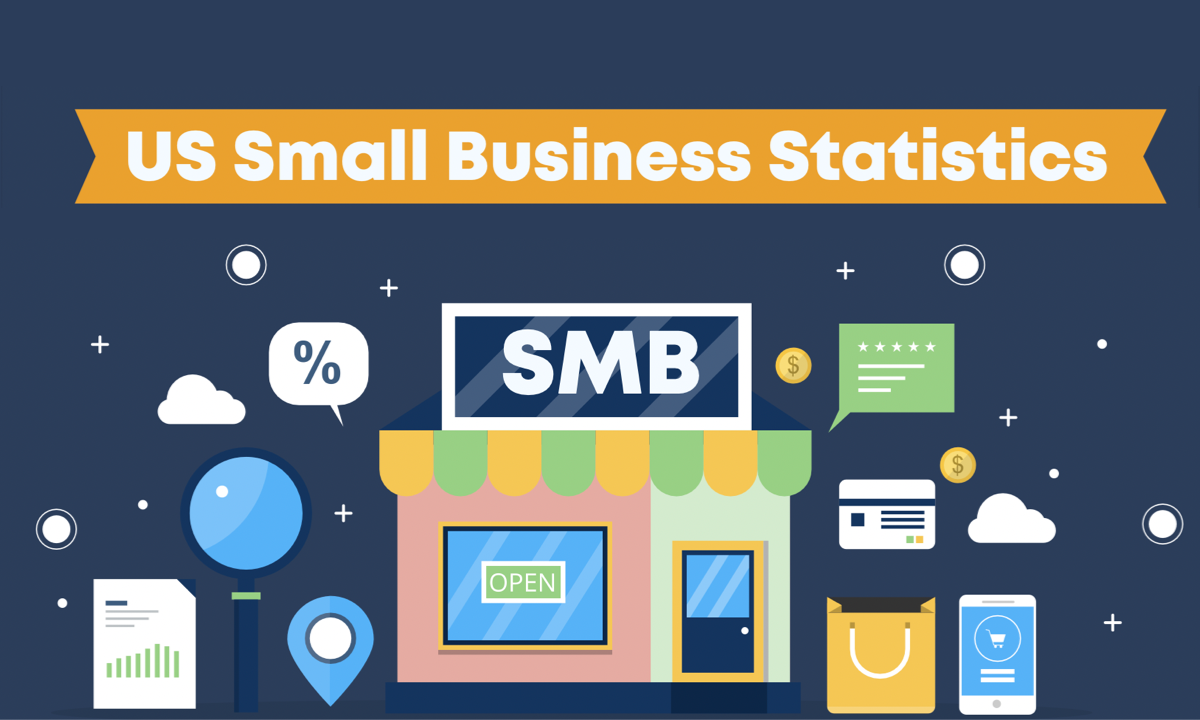
The pandemic changed how companies operated and brought with it the so-called “great resignation”, with many people quitting their jobs to start their own businesses. What does that mean for existing small businesses in the US? What is the demographic of new small business owners? What are the small business statistics in 2022?
In this article on small business statistics, we will cover all the relevant figures to help you understand the small business space in the United States. If you want to establish a small business and don’t know where to begin in terms of understanding the market, fret not—we are here to help. These small business statistics, based on the data from the Small Business Administration and Guidant Financial, will help you understand how small businesses influence the economy and what factors impact them.
We also have a handy infographic for you to quickly glance through the most important statistics!
(Aside: Check out our list of sites to create great business cards).
A better way to manage your finances
With Hiveage you can send elegant invoices to your customers, accept online payments, and manage your team — all in one place.
How many small businesses are there (according to Small Business Administration)?
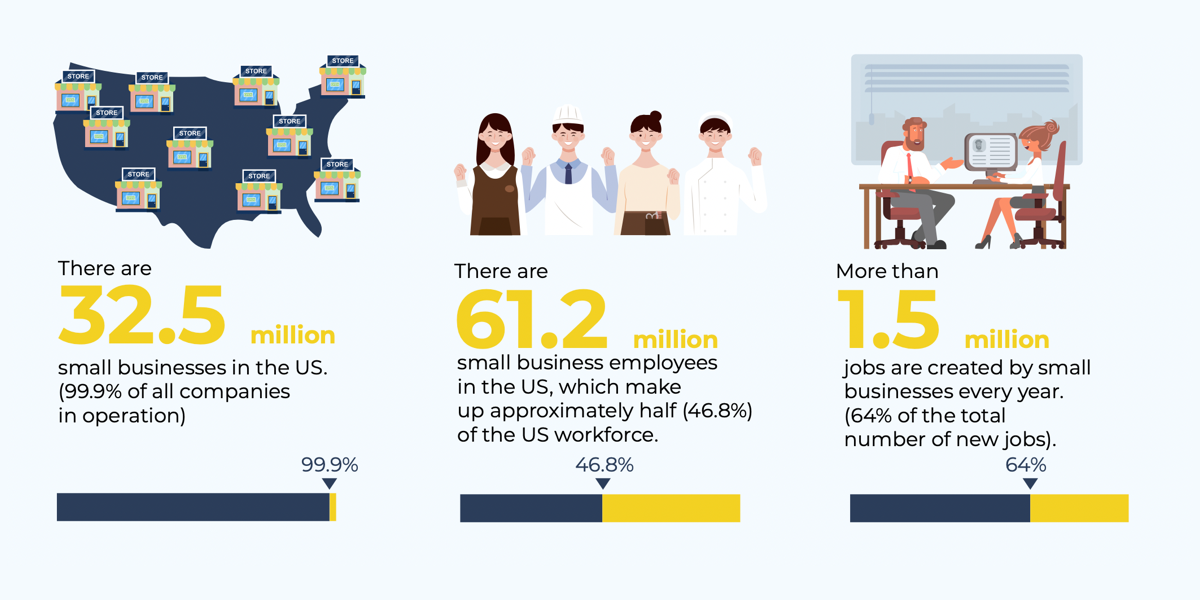
The Small Business Administration defines any organization with fewer than 500 employees as a small business. In the United States, small businesses make up 99.9% of all companies in operation. That means there are 30.7 million small businesses in the country. This is a staggering figure, and these enterprises create about 1.5 million jobs yearly, which is about 64% of the total new jobs in the US.
The Uncertainty of Entrepreneurship
Before starting a small business, you have to know that more than half of new small businesses fail within their first year of inception, and more than 95% of startups fail within the next five years. It’s also worth noting that one of the setbacks you’ll face when establishing a startup is the poor quality of labor.
These shouldn’t be reasons for discourage, but such small business statistics remind us that there will be challenges ahead for most small business owners.
Why do people become small business owners?
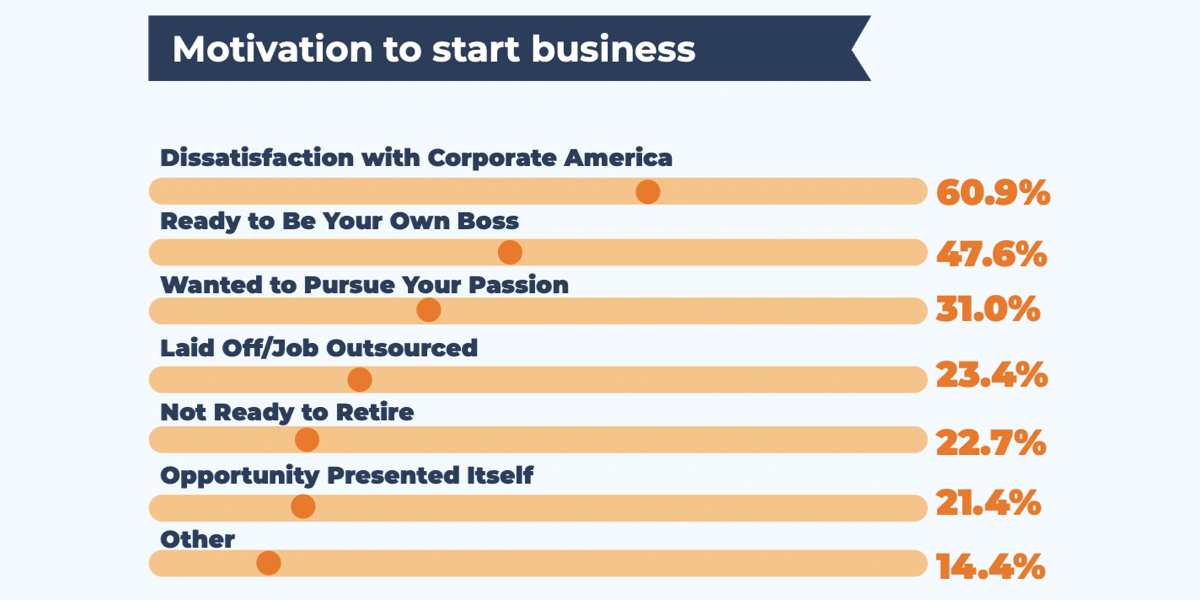
Over the years, there has been a rise in the general population leaving employment behind and venturing into entrepreneurship. This hasn't come out of the blue, though, as many former employees are now looking for conducive work environments, following their passions, and wanting to be their own bosses.
While the pandemic undoubtedly contributed to more people opting to start their own trades, one of the main reasons is that 60.87% of business owners were ready to be self-reliant. Those who ventured into business because they were dissatisfied with corporate America cater for 47.64%.
Others, 31%, dived head first into business solely to pursue their passions, something they couldn't do while in their full-time jobs. About 21.36% of small business owners work for themselves because they saw the perfect opportunity to exploit. In comparison, a staggering 23.44% of those who started their businesses did so after they became unemployed.
Sometimes retirement comes with boredom and financial insecurity, which explains why more than 20% of business owners founded their small businesses. They attributed this to their desire to keep working, something we think will significantly influence more retirees.
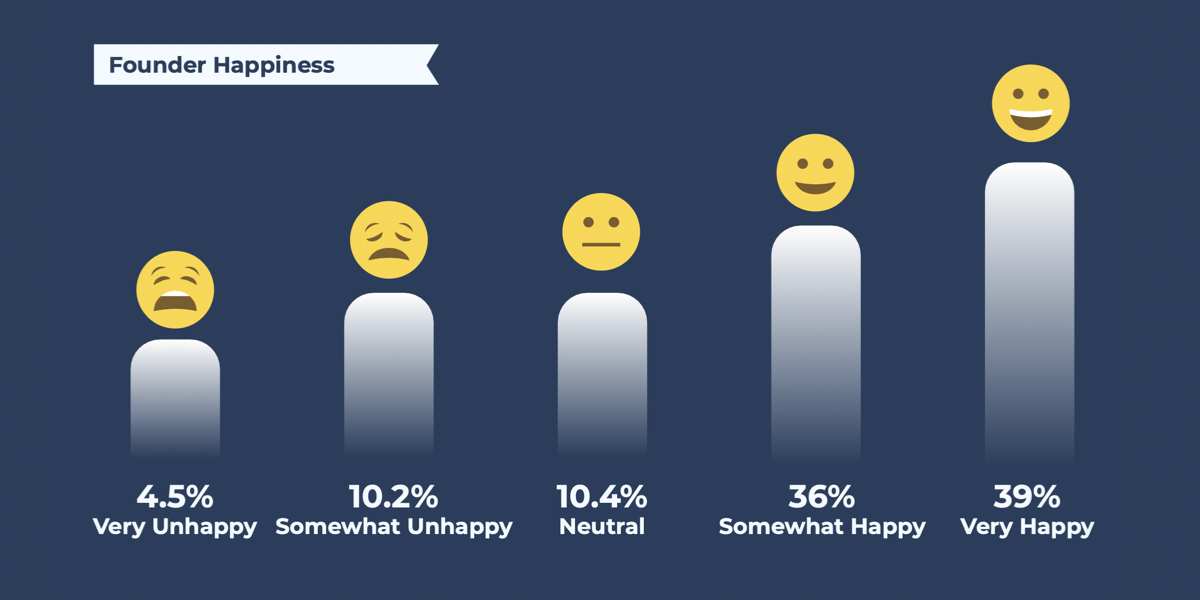
Despite the difficulties of establishing a new business, including Covid 19, and difficulty hiring employees, 39% of business owners reported that they were very happy in their new ventures. About 36% of them were somewhat satisfied, with 10.3% neutral. The very unhappy business owners made up 4.5%, while 10.2% were somewhat dissatisfied with their business decisions.
Generally, if we compare those small business statistics with the happiness statistics, the business owners are happier than the average American. That’s quite a fascinating insight, which has been somewhat proven by the large numbers of people who have quit formal employment.
Who is the Small Business Owner in 2022: A Profile
Considering that it takes approximately five days to start a business in the US (as per Small Business Administration data), it isn't surprising that more families are venturing into business ventures. As per the statistics, 29% of small businesses are family-owned. The main sectors in the family-owned businesses are company management and utility services which account for 47%.
On the other hand, social assistance and healthcare had the smallest share at 16%, which is understandable. The government controls this sector, making it quite difficult for independent business owners to thrive.
Age Group of Small Business Owner
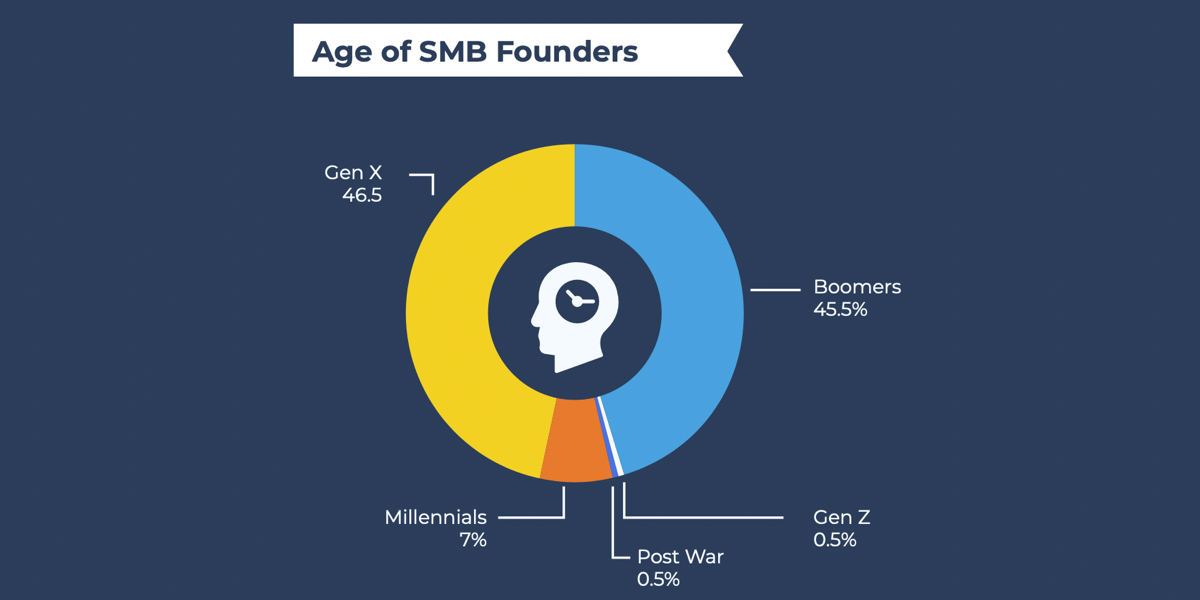
While many millennials are said to have ventured into business, small business statistics show that they are not the dominant age group among the business owners in 2022. Interestingly, Gen X makes up 46.5% of business owners, followed by Boomers, who take up 45.5% of the businesses.
Despite reports that business ownership among Millennials has grown sporadically over the past couple of years, they hold 7% of companies. The youngest and oldest generations hold the minority share of the small businesses, with Post-war owners and Gen Z collectively making up 1%.
These small business statistics are pretty astonishing, as there is a projected growth in business ownership among Gen X. While many Millennials are undoubtedly venturing into entrepreneurship and building their own business primarily to pursue their passions, they haven’t classified their ventures as small businesses, which has contributed to their small percentage.
A better way to manage your finances
With Hiveage you can send elegant invoices to your customers, accept online payments, and manage your team — all in one place.
If you’re looking to start a business, statistics show that the likelihood of your business succeeding starts from the mid-30s until when you’re 50 years old. The probability of a successful startup decreases drastically for people over 50 years old.
Gender of Small Business Owner
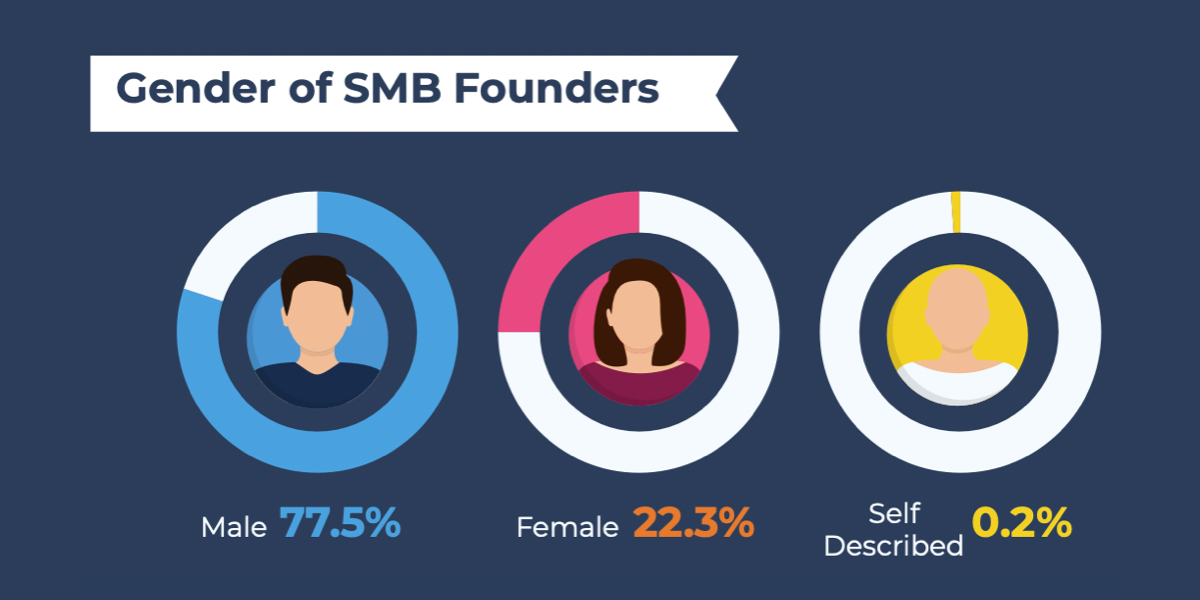
When it comes to gender, it doesn't come as a shock that more men own businesses compared to women. Women entrepreneurs in the US make up 23.3,% while their male counterparts account for a massive 76.5% of small businesses.
The LGBTQ community and other people who self-describe own a paltry 1%. The trend is consistent with what is happening all over America, with more men involved in their own business than women.
Still, there are some impressive small business statistics in the female-owned business world. It’s estimated that at least 51% of small businesses in the US are owned, controlled, or operated by one or more women. The said businesses generate over $1.7 trillion in revenue and employ around 9 million people. Considering that women-owned firms have grown by 114% over the past two decades, chances are the number will also increase within the year.
By and large, when it comes to women-owned businesses, black women represent the highest number of the demographic. 46% of black business people are women, which is the highest of any race.
Launching one’s own business is hard enough, but some of the difficulties that women generally face in startups include advertising and marketing 24%, lack of capital, and cash flow accounts for 17%. In comparison, 15% of the owners faced difficulty hiring and retaining employees. About 14% had trouble managing and providing benefits and 13% didn't effectively handle administrative tasks.
To fund the startup, 44% of female owners use their cash, 15% go for ROBS, and a further 13% get the funding from their family and friends. Another 7% go for a line of credit, SBA loans cater for 7%, and 5% of them opt for unsecured loans. 3% use equipment leases, and 6% go for other sources of funding.
Race of Small Business Owner
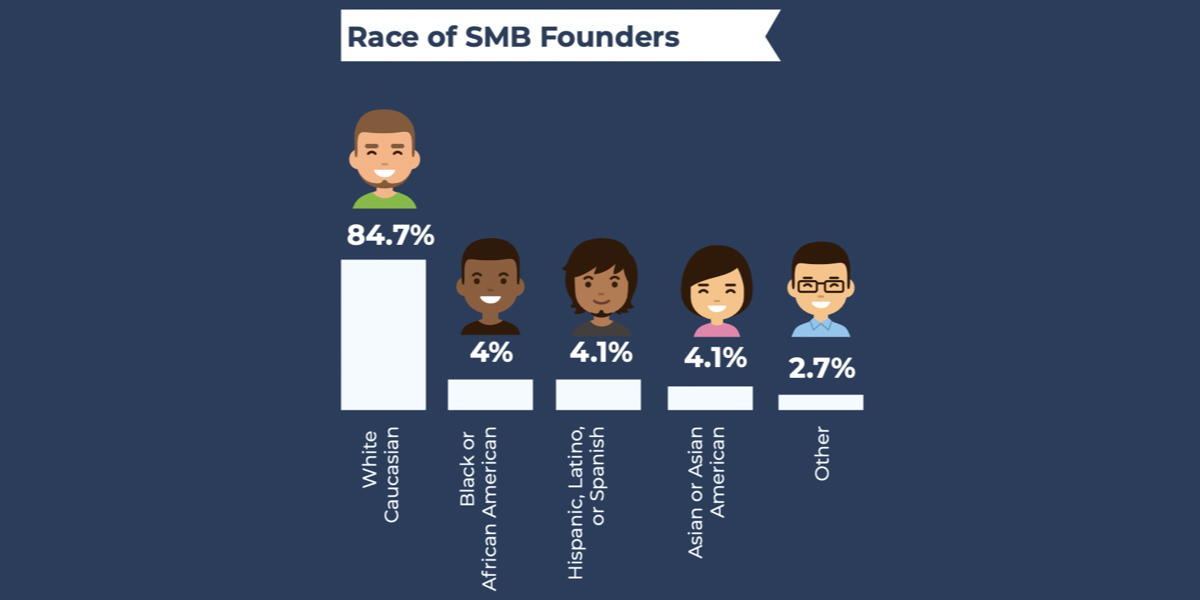
Diversity in business is important in any country and economy, but there seems to be a disparity between all the different races in the US. The White or Caucasians overwhelmingly own 84.7% of small businesses, while the Black or African- American demographic makes up 4.1%. The Hispanic, Latino, or Spanish Origin take for 4.2%, the same as people of Asian or Asian American origin. The Native Americans, Middle Eastern people, Native Hawaiian, and Pacific Islanders make up 4% of all small businesses.
The previous years have seen a growth in diversity in business ownership, but the same cannot be said for this year. This can be attributed to a couple of factors, though, including the effects of the pandemic. Hopefully, 2022 will see an improvement in these small business statistics, where more people of color, women, and other minority groups will own small businesses.
Starting one’s own business can be challenging, especially when you don’t have enough funding. Many minority startups are not likely to get outside financing, which means that they have to dip into their savings to kickstart their business. Some also get help from their families.
Small business statistics also show that 17.6% of black Americans depend on their credit cards to get sufficient funding for their own business.
Recent estimates also show that people from a minority background own over 8 million small businesses. Despite people from the minority demographic holding businesses that employ about 8.7 million people, they receive half the amount of investments compared to white-owned companies.
When it comes to the biggest-owned small business sector by minorities, the social assistance and health care industries take up 37% of all minority-owned businesses.
Political affiliationof Small Business Owner
Politics play a huge role in the success of any business, and in America, it’s no different. Different people have their political party affiliations with the Republican supporters making up 40.6%. The independent or unaffiliated voters come in second, accounting for 31.9% of the businesses, while the Democrats take up 21.9%. Those affiliated with the Libertarian and Green parties are 5.4% and 0.2%, respectively. Whether that will change within the year remains to be seen as more people venture into business.
Establishing a Small Business
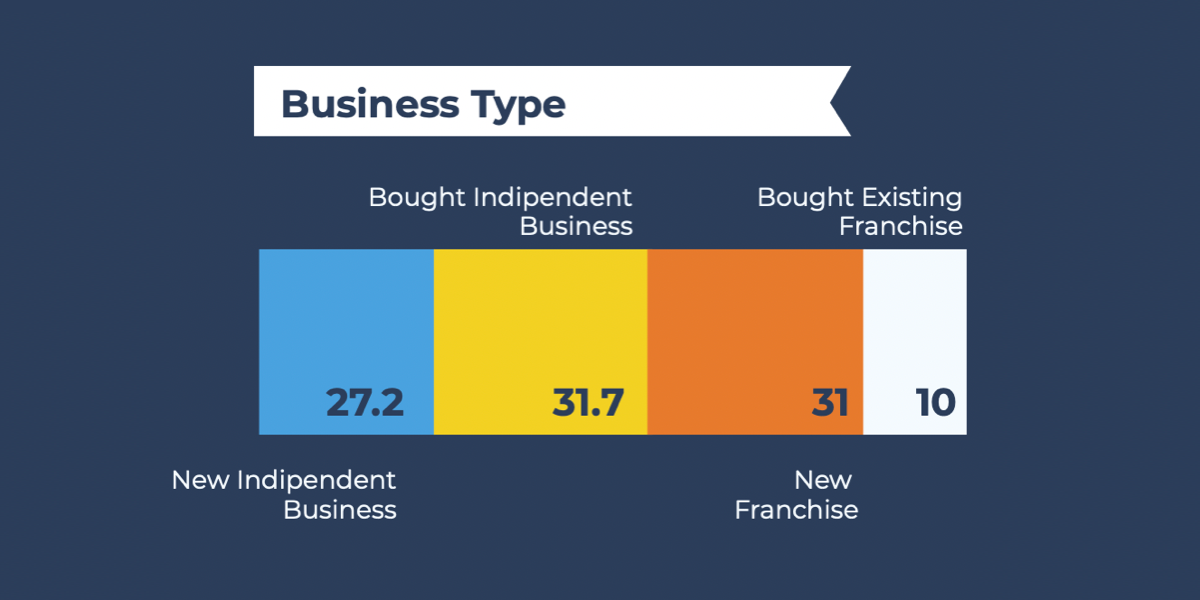
According to small business statistics, 27.2% of business owners start their ventures independently from scratch. These build their businesses from the ground up. The ones who bought their independent businesses from other small owners account for 31.7%.
It’s essential to recognize that 31% of new small business owners chose to put money into new franchise locations, with only 10% opting for existing sites. While there are 30.7 million small businesses in the US, 3.7 million are considered micro-businesses, with between one and nine employees.
A better way to manage your finances
With Hiveage you can send elegant invoices to your customers, accept online payments, and manage your team — all in one place.
Many people are looking to diversify their sources of income, hence the branching into small businesses. Some of the fastest-growing business sectors include food and restaurant which takes up 11%, business services (11%), and health, beauty, and fitness account for 10%. General retail accounts for 7% of the new businesses, and home services take up 6%.
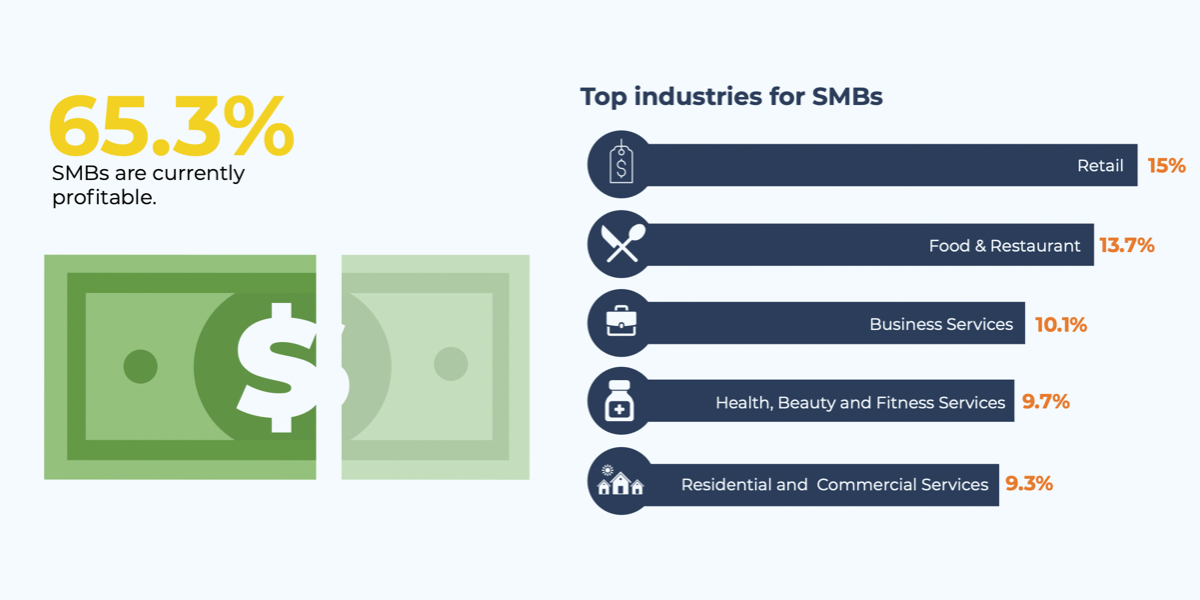
Food and RestaurantSmall Businesses
If you want to dive into the food and restaurant sector, here are some of the numbers you should know:
- The food and restaurant sector accounts for 12% of all small businesses.
- By 2025, the value of the accommodation and food industry is projected to grow to $14.8 billion.
- Between 2019 and 2020, sales in the restaurant and food sector dropped by -19.2%. Still, the sales are projected to bounce back in 2021 to +10.2%.
Retail Industry Small Businesses
The retail business sector accounts for 11% of the small businesses. When the COVID-19 pandemic hit, the industry was affected massively, with sales reducing by 6% to $4.56 billion. Still, with the pandemic effects easing around the world, it’s estimated that the value of the retail sector will grow to $5.52 billion in 2026.
Business Services Sector Small Businesses
Like every other business, the pandemic hit the service industry hard. The numbers dropped drastically in 2020, with a significant 16% drop. Despite its slow recovery, the sector is projected to grow in value to $2.41 billion.
Beauty, Health, and Fitness Services Industry Small Businesses
The health, beauty, and fitness service accounts for 9% of the small businesses. The sector, especially health services, is expected to bounce back significantly after the pandemic, with a growth rate of 16.6%.
The estimated health services revenue in 2026 is projected to hit $38 million, while the industry value would be over $4.32 trillion. On the other hand, the beauty services sector's forecast value is estimated to be $14.8 billion. This makes it one of the most lucrative business ventures in the country.
Residential and Commercial Services Industry Small Businesses
7% of small businesses are in the residential and commercial services sector. The growth in this industry is steady, with the growth rate between 2019 and 2020 increasing by 1.14%.
Interestingly, you don't need a college degree or to have graduated to start your own business. According to the US small business statistics, only 44% of small business owners have a bachelor's degree. 31% of independent owners have an associate degree or have completed a college course but didn't graduate.
A better way to manage your finances
With Hiveage you can send elegant invoices to your customers, accept online payments, and manage your team — all in one place.
Those who graduated from high school or earned a GED (General Educational Development) certificate make up 20% of the business owners, while 5% of them are high school dropouts. This shows that anyone can start a small business and thrive, regardless of their educational background. With that, it’s no wonder 543,000 businesses are started every month.
Income Range of Small Businesses
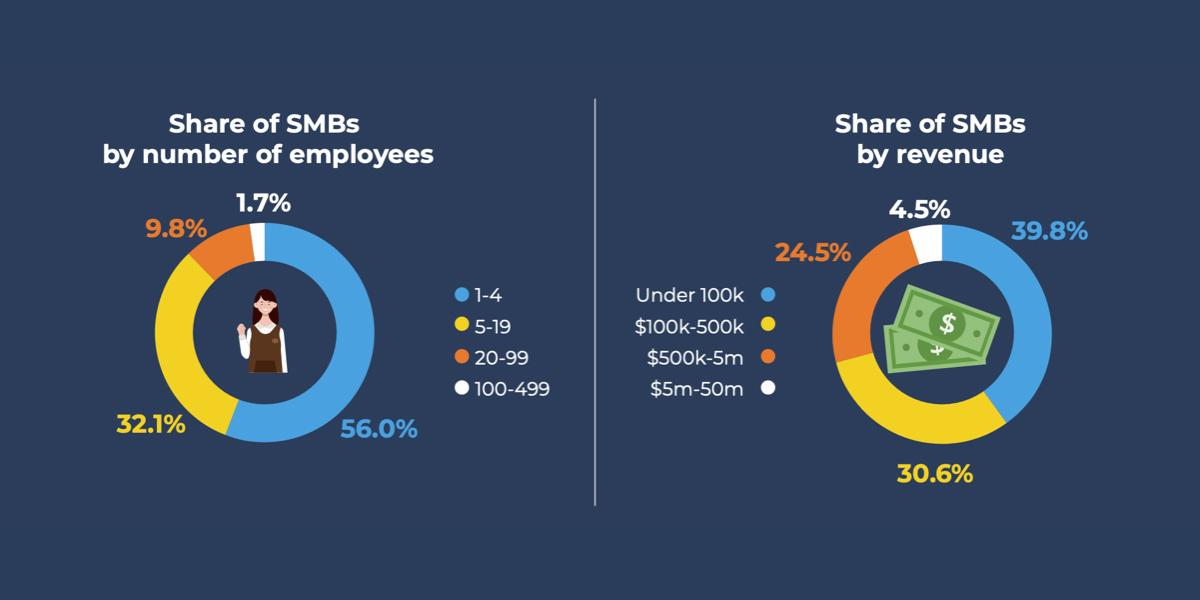
We presume that you want to start a business because you want to make money and be your own boss. As such, it’s vital that we discuss the income statistics so that you are in the know before diving into your new venture.
On average, a small business with no employees has an annual revenue of about $46,978. The business owner makes an average of $71,813 per year, while 86.3% of the small business owners have an income of less than $100,000 annually.
Employment
In many economies, small businesses are the main contributor, and it’s no different in the US. In fact, towns like Wyoming and Montana depend solely on small businesses. Small businesses are among the biggest recruits, creating 1.5 million job opportunities. Where there are new jobs, 64% of those are specifically for small businesses.
small business statistics show that small enterprises are big on efficiency, and to achieve that, 37% of them outsource their labor. In terms of numbers of employees, 41% of the businesses have between two and five employees. Small enterprises with less than 100 employees make for the largest share of the small business industry.
Impact of the Pandemic
COVID-19 took a toll on all businesses, but the small enterprises were the most affected. When asked if the impact of the pandemic on their businesses was over, most business owners were quite pessimistic. 54.6% of them said the effects of the pandemic would linger on for a while, while 19.4% felt that it was over. 26% of the small enterprise owners were unsure.
With many businesses shutting down operations during the pandemic, the small businesses that survived were pretty optimistic. 85.4% of owners are confident that their ventures will weather the pandemic, while 13.1% are unsure of their businesses’ survival. 1.5% of the small business owners are confident that as the pandemic goes on, their enterprises won't survive.
Essential Skills for Employees
With most small businesses employing around five to a hundred employees, business owners have a massive task in getting the perfect person for the job. So what are the qualities and skills you should be looking for when you want to expand operations?
- Communication. 54.6% of small business owners want someone with refined communication skills.
- Teamwork. No business will succeed without collaboration in their ranks, which is why 46.6% of the owners look for employees who can work comfortably in a team.
- Sales. The business aims to make some profits; the only way to do that is by selling the products. 38.4% of small enterprise owners are looking for a person with a sales and customer relationship management background to add to their team.
- Critical thinking. About 36.4% of small business owners want someone with critical thinking and problem-solving skills.
- Adaptability. The ability to adapt to different circumstances and locations is one of the critical skills many owners are looking for. 36.4% of them say that their employees should be able to adapt whenever necessary.
Hiring and The Great Resignation
During the past years, with the pandemic raging over the world, the US has witnessed a considerable number of people resigning from their jobs. This has made it difficult for businesses to cope, especially with the workforce shortage.
When asked how hard it is to hire people, 39% of business owners lamented that it was very difficult, while 31.7% said it’s somewhat tricky. 25.8% of the owners didnt see any difference, and 2.4% said it is slightly easy to recruit new employees. A further 1.1% said it was very easy to hire.
A better way to manage your finances
With Hiveage you can send elegant invoices to your customers, accept online payments, and manage your team — all in one place.
As per the small business statistics, hiring is quite difficult. Some of the factors that made it difficult to fill the posts include:
- 46.9% of business owners reported that there was a lack of interest in their businesses which translated to a small number of applicants.
- 30.4% cited competition from other employers as one of the reasons why they couldn't bring new people in.
- Lack of required work experience by candidates who applied accounted for 27.1%.
- 23.7% of the small business owners said that the candidates who applied for the positions lacked the required technical skills.
Marketing and Advertising
For any business to be successful, they need to invest in marketing and advertising. This helps create awareness about the products or services they offer, and small business owners have to do more advertising than their already established counterparts.
Small business statistics show that 47% of small businesses do their marketing and advertising independently. While it might be less costly, it results in improper planning and optimization. Only 20.77% of business owners in the US spend more than ten hours marketing on social media which means the brand’s reach is not as vast as expected. To maximize social media, hiring a marketing expert to handle your marketing campaigns is recommended.
With the exponential growth of internet services, more businesses are moving their operations online. Considering that over 307.2 million people in the US use the internet, it only makes sense for small business owners to market their enterprises online.
Most small businesses opt to use digital mediums to run their adverts compared to traditional methods. Apart from social media marketing which is the most popular channel, online marketing comes in second with 49%, with print marketing taking up 36%. Only 22% of small businesses use television advertising.
With many people spending their time on social media, it’s estimated that 55% of consumers find new brands on various platforms. Gen Z is more likely to find out about your brand, with 78% of them using social media regularly, followed by 61% of millennials. Only 56% of Gen X and 35% of baby boomers scroll through social media to look for new products.
According to available US small business statistics, 90 million small business owners used Facebook to promote their brands, products, or services. The social media platform is also common among many business owners, with 86% of them using Facebook as their primary place for advertising.
Numbers also show that if a small enterprise has less than 10,000 followers on Facebook and posts more than 60 times each month, it’ll receive 60% fewer clicks per post than a business publishing five times or fewer per month.
Social media advertising is one of the leading small business marketing strategies, with 64% of new business owners opting to put their products online.
The importance of advertising cannot be overlooked; according to the surveys, 75% of small businesses use paid advertising. This includes boosted posts and long-term social media marketing campaigns. This figure will undoubtedly grow as more companies are established in the coming years.
Nowadays, shopping from your phone or PC is pretty easy, as more companies have moved their operations online. Still, that doesnt mean that we haven't had some bad experiences, either the product is faulty or wasn't delivered in good time. Chances are, if you have a terrible experience, you won't return to that site. 88% of consumers who have shopped online are unlikely to return if their experiences were less than satisfactory.
Do you want to reach more customers through your website? One of the ways to convert clicks to economic value is by adding a blog to your website. A small company with a blog embedded on its website will generate 126% lead economic activity.
No business will thrive without good advertising campaigns. Even so, it’s interesting to note that 80% of small enterprises have not appreciated the value of content marketing. While they invest in general marketing, they haven't zeroed in on specific, targeted posts online.
Also, it’s important to note that if your business targets millennials and Gen Z, you should invest in social media marketing to improve your brand exposure. Platforms like TikTok and Instagram are popular among that demographic.
Small Business Financial Figures
So you have come up with a waterproof business plan and want to launch your own small business. Yet, you don't know what the financial statistics are for the year. Don't worry; we have you covered. Knowing how existing businesses are doing financially gives you an idea of what to expect once you start your enterprise. Here are some of the statistics you need to know.
- For 39% of new business owners, they started their businesses using cash instead of going to alternative lenders.
- Many small business owners have a challenge in cash flow, with 28% of them confirming this fact.
- The overall average loan amount for a small business is $107,000.
- Small businesses contribute massively to the amount of tax collected, with the enterprises paying an average effective 19.8% tax rate.
- Despite a significant number of businesses failing as soon as they start due to different factors, it doesnt mean they are not profitable. According to a survey done by Guidant Financial and Lending Club, 78% of small business owners considered their business to be a profitable one.
- Between 1998 and 2014, the small businesses' share of the overall US GDP dropped from 48% to 43.5%.
A better way to manage your finances
With Hiveage you can send elegant invoices to your customers, accept online payments, and manage your team — all in one place.
Another interesting statistic that you should know is that 43% of cyber attacks target small businesses. Some of the most common attacks on small enterprises include:
- Phishing - 57%
- Stolen or compromised devices - 33%
- Credential theft - 30%
While the growth of the internet is a great thing, more small business owners should be careful to protect their enterprises from cyber attacks. Considering that 60% of small companies shut down operations six months after the attacks and the effects linger for over three years, taking steps to avoid the cyber onslaught is essential.
Infographic
Would you like to grab these stats in the form of a handy infographic? Download as PDF or JPG.
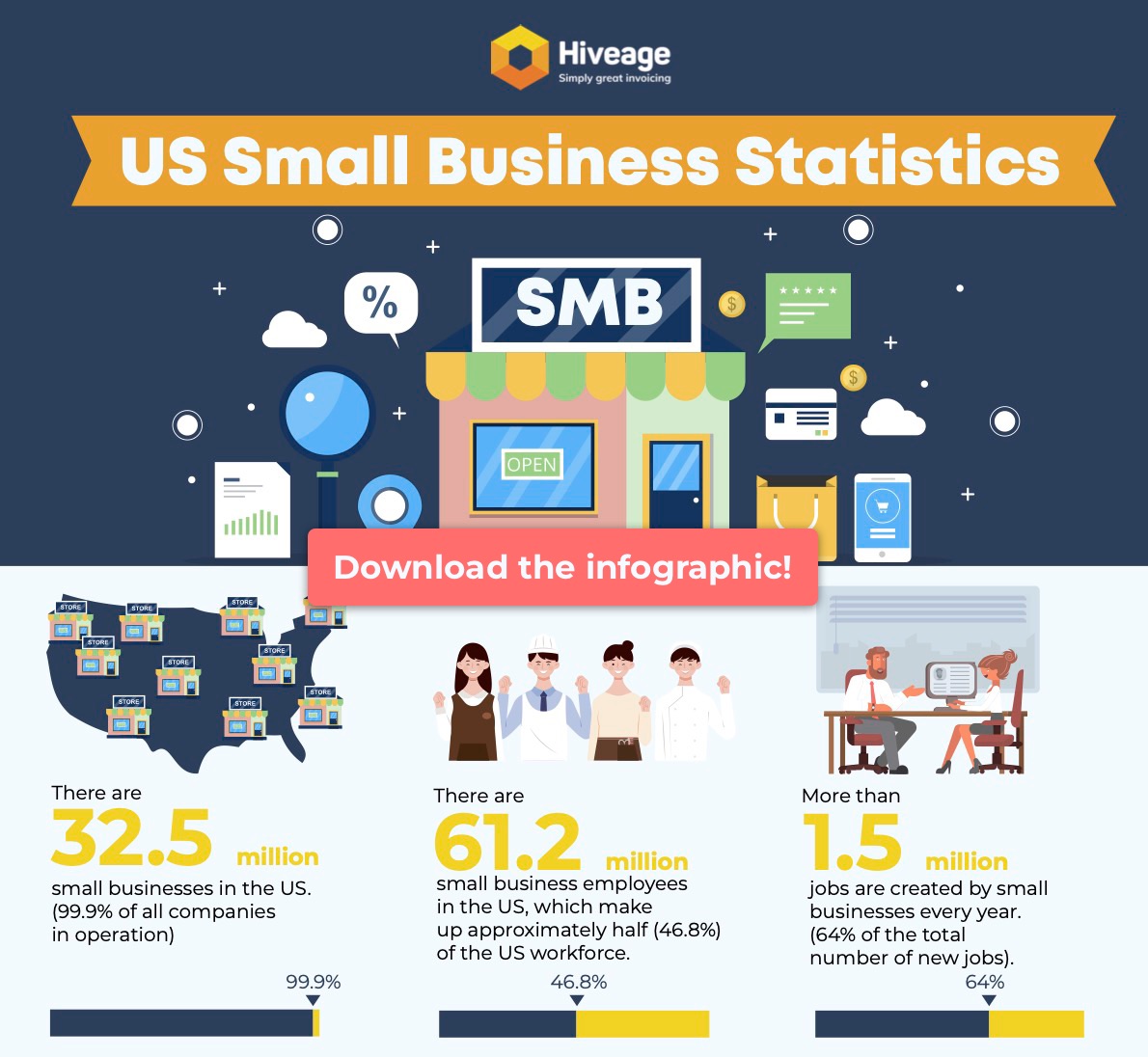
Conclusion
Starting a side hustle can be daunting and depressing, but it doesnt have to be. Whether you are starting a business to become your own boss or have a product or service that can take the world by storm, it’s now easier than ever to establish one.
The Small Business Administration expects that small businesses in 2022 are going to be impacted significantly. The pandemic is slowing down, and more companies are cropping up, which means there’s massive competition. Before venturing into a new business, do your due diligence and research extensively. That will help you know what you are getting yourself into, and with the statistics outlined above, you have sufficient information when it comes to choosing a suitable business.
A better way to manage your finances
With Hiveage you can send elegant invoices to your customers, accept online payments, and manage your team — all in one place.
While you will face some challenges in the course of your business venture, understanding these current trends will help you make better decisions when needed. You can make your venture successful with dedication, hard work, and passion.
If you are wondering how to go about managing your small business, we at Hiveage are well equipped to help you out. We deal with preparing invoices, tracking expenses, financial reports, managing teams, and recurring bills, among other services. Get in touch with us today for all your online business needs.
Join thousands of business-savvy entrepreneurs on our mailing list.
Curated emails that’ll help you manage your finances better.




